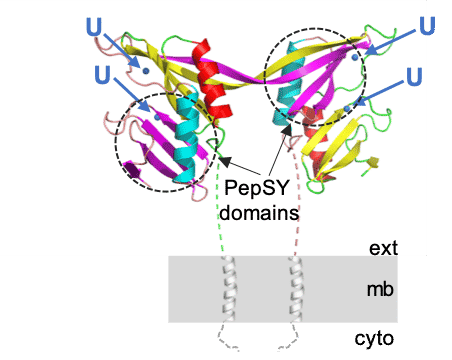collaboration involving the CEA-BIAM and the CEA-Joliot has revealed a mechanism that would allow soil bacteria to protect themselves against uranium in the environment. Access of the radionuclide to the cell would be blocked by a protein capable of binding not only uranium but also iron.

BIAM researchers are exploring the mechanisms of adaptation of bacteria to the presence of radioactive elements, and in particular the cellular response induced by the uranyl ion (UO22+), the soluble form of uranium. For several years, they have been studying four strains of Microbacterium, isolated from metal- and radionuclides-rich soils rich, taken from naturally uraniferous soils of the Limousin and from other sites (Chernobyl in particular).
By inventorying all the bacterial proteins under particular conditions, according to a proteogenomic approach, they show that uranyl exposure strongly affects the cellular metabolism of the bacteria, impacting more particularly that of phosphate and iron.
After 24 hours of uranyl exposure, they found that a protein – named UipA for Uranium Induced Protein A – was overproduced. Its function is unknown, but its presence is associated with uranium-tolerant bacterial strains.
Using a combination of biochemical, spectroscopic and crystallographic techniques, biologists discovered that this protein is exposed at the cell surface and that it contains a domain (PepSY) that has a very high affinity not only for uranyl but also for the Fe3+ cation. In other words, a specific site of the UipA protein, exposed to the outside, allows the capture of UO22+ ions, preventing the entry of this ion into the cell.
“A previously unknown function of the PepSY domains has been revealed, which allows us to focus our research on the importance of proteins with this domain in the iron capture and transport mechanisms,” says Virginie Chapon, a researcher at BIAM. Iron plays an essential role in living organisms. A better understanding of the role of proteins containing the PepSY domain in the mechanisms of its absorption could have an impact in various fields of biology, particularly in pathogenic bacteria. This work was carried out in collaboration with IRSN and the University of Nice.

REFERENCE : Gallois, N., Alpha-Bazin, B., Bremond, N. et al. Discovery and characterization of UipA, a uranium- and iron-binding PepSY protein involved in uranium tolerance by soil bacteria. ISME J (2021).
Discovery and characterization of UipA, a uranium- and iron-binding PepSY protein involved in uranium tolerance by soil bacteria, ISME Journal: https://www.nature.com/articles/s41396-021-01113-7